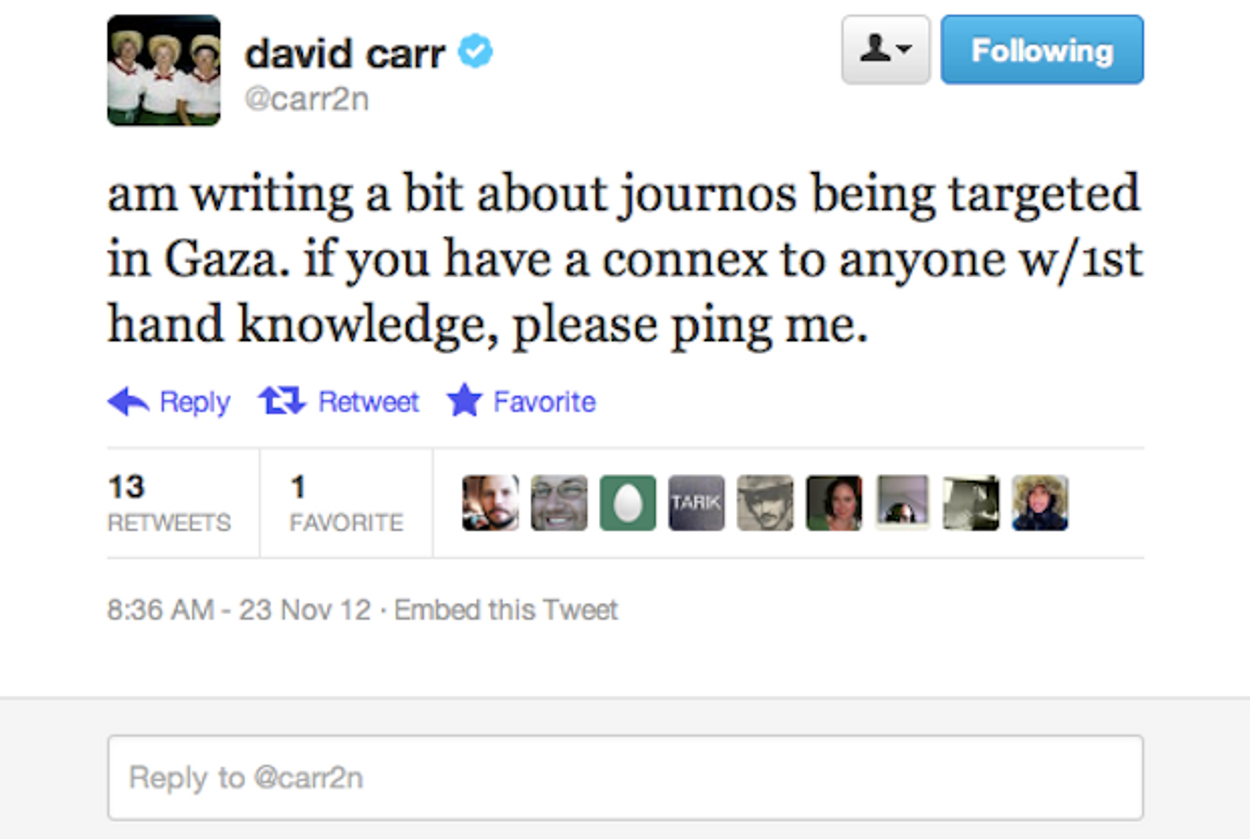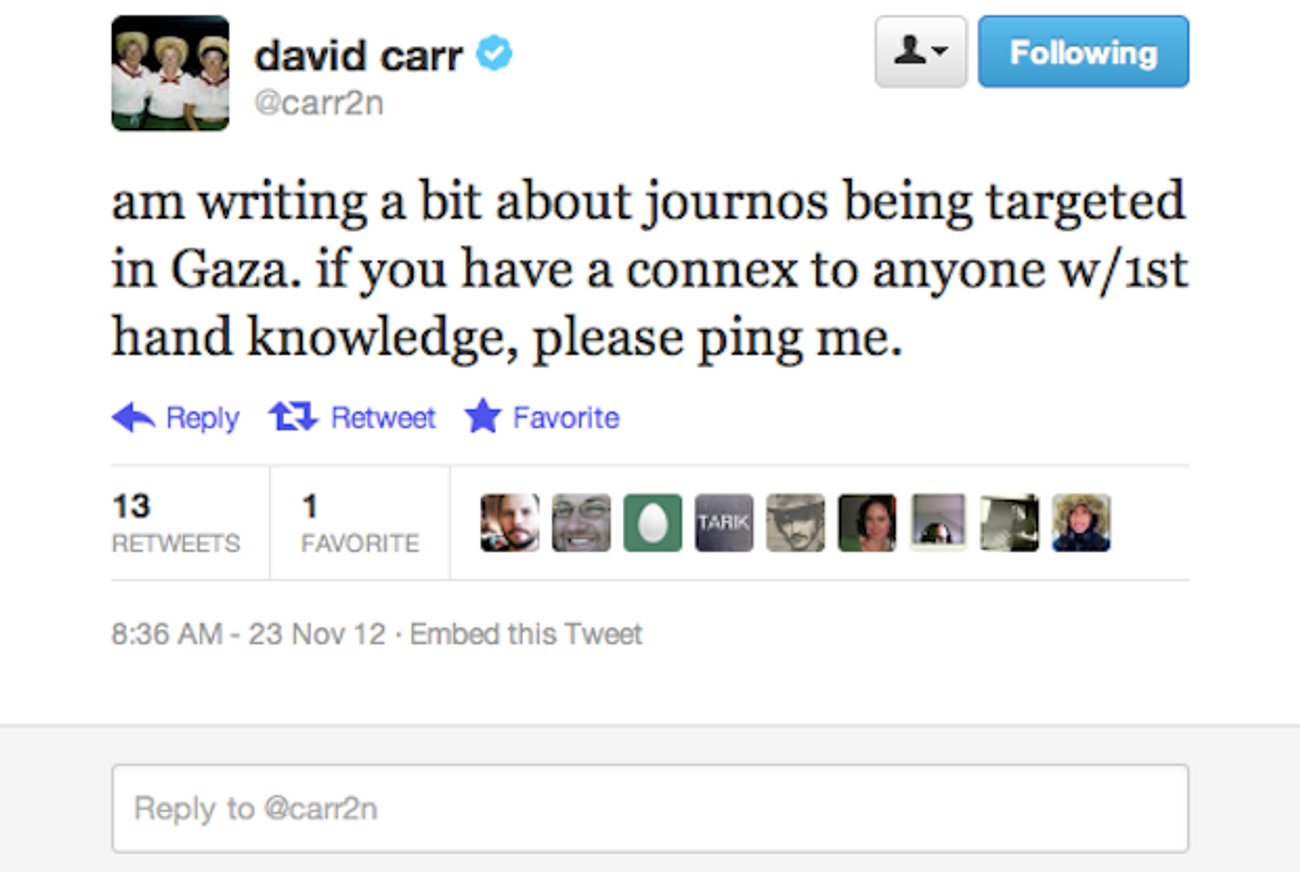Times Mistakes Gaza Terrorists For Journalists
David Carr makes a huge reporting mistake




There are few journalists who write as capably and accessibly about media and journalism trends as the Times‘ David Carr. A lot of people seem to carry this opinion, so I imagine there was some surprise when the above-pictured tweet went out from Carr’s Twitter account to his 400,000 or so followers.
Carr had decided to go fishing for a story about journalists who had been targeted in Gaza during Operation Pillar of Defense. As someone who followed the war closely, I assumed that his unnerving search would yield little results; after all, for a mind as insightful and sharply tuned to nuance as Carr’s, I wouldn’t have expected him to bite on a story that wasn’t true. But he did.
In his ominously-titled column “Using War as Cover to Target Journalists” today, Carr starts by describing a scene at a Waldorf Astoria gala for the Committee to Protect Journalists, before citing one of the organization’s grim statistics:
The C.P.J. reports that government officials and their allies are now suspected of being responsible for more than a third of the murders of journalists, a higher proportion than killings attributed to terrorist groups or criminal enterprises.
For his first example, Carr doesn’t dig into Syria, where approximately 20 journalists were killed from November of last year until this September. He doesn’t start with Russia or Mexico either. He starts, of course, in Gaza.
On the same day as the Waldorf event, three employees of news organizations were killed in Gaza by Israeli missiles. Rather than suggesting it was a mistake, or denying responsibility, an Israeli Defense Forces spokeswoman, Lt. Col. Avital Leibovich, told The Associated Press, “The targets are people who have relevance to terror activity.”
So it has come to this: killing members of the news media can be justified by a phrase as amorphous as “relevance to terror activity.”
The outrage would be righteous if the men were simply journalists. But when Leibovich told the AP that the men were linked to terrorist activity, she wasn’t making some callous statement about targeting journalists who disagree with the state.
As the IDF Blog reported (or really anyone with internet access could have reported), one of the men killed was a senior Hamas member:
Muhammed Shamalah, commander of Hamas forces in the southern Strip and head of the Hamas militant training programs, was targeted by an Israeli air strike while driving a car clearly labelled “TV”, indicating it to be a press vehicle, abusing the protection afforded to journalists.
To that the Elder of Ziyon added about Mohamed Abu Aisha, a man whom Carr describes as the “director of the private Al-Quds Educational Radio” in the story:
In the case of Mohamed Abu Aisha, he clearly was a uniform-wearing member of Islamic Jihad. Islamic Jihad doesn’t describe him as a journalist, but as an instructor for the Mujahideen of Al-Quds Brigades in Deir al-Balah Battalion Brigade.
The post includes a picture of Aisha in his military garb. Carr goes on for paragraphs more, citing excoriations by Human Rights Watch and Reporters Without Borders as proof of Israeli perniciousness. He then rightly and finally delves into the rest of the world, saving a remark about Syria–“the deadliest country for journalists this year”–to kick off one of the last paragraphs on the article’s second page.
Of course, Carr’s not wrong to want to defend journalists. But what about the truth?
At Leasts 19 Journalist Killed in Syria Since November [Reuters]
Senior Terrorist in Gaza Disguises Himself as Journalist [IDF]
Or Journalists as Cover for Waging War [Elders]
Adam Chandler was previously a staff writer at Tablet. His work has appeared in the New York Times, the Wall Street Journal, the Atlantic, Slate, Esquire, New York, and elsewhere. He tweets @allmychandler.